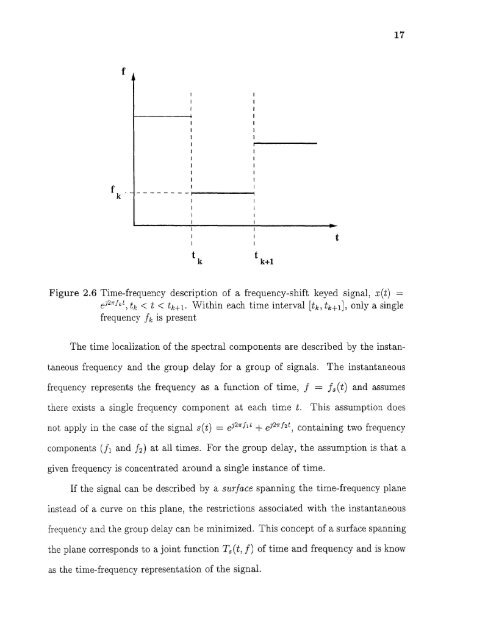Space/time/frequency methods in adaptive radar - New Jersey ...
Space/time/frequency methods in adaptive radar - New Jersey ...
Space/time/frequency methods in adaptive radar - New Jersey ...
Create successful ePaper yourself
Turn your PDF publications into a flip-book with our unique Google optimized e-Paper software.
17Figure 2.6 Time-<strong>frequency</strong> description of a <strong>frequency</strong>-shift keyed signal, x(t) =e327rf“, t k < t < tk+1 -With<strong>in</strong> each <strong>time</strong> <strong>in</strong>terval [t k , tk+1], only a s<strong>in</strong>gle<strong>frequency</strong> ƒk is presentThe <strong>time</strong> localization of the spectral components are described by the <strong>in</strong>stantaneous<strong>frequency</strong> and the group delay for a group of signals. The <strong>in</strong>stantaneous<strong>frequency</strong> represents the <strong>frequency</strong> as a function of <strong>time</strong>, ƒ ƒs (t) and assumesthere exists a s<strong>in</strong>gle <strong>frequency</strong> component at each <strong>time</strong> t. This assumption doesnot apply <strong>in</strong> the case of the signal s(t) ej2rf i t e327f2t, conta<strong>in</strong><strong>in</strong>g two <strong>frequency</strong>components (ƒ1 and f2 ) at all <strong>time</strong>s. For the group delay, the assumption is that agiven <strong>frequency</strong> is concentrated around a s<strong>in</strong>gle <strong>in</strong>stance of <strong>time</strong>.If the signal can be described by a surƒace spann<strong>in</strong>g the <strong>time</strong>-<strong>frequency</strong> plane<strong>in</strong>stead of a curve on this plane, the restrictions associated with the <strong>in</strong>stantaneous<strong>frequency</strong> and the group delay can be m<strong>in</strong>imized. This concept of a surface spann<strong>in</strong>gthe plane corresponds to a jo<strong>in</strong>t function Ts(t, ƒ) of <strong>time</strong> and <strong>frequency</strong> and is knowas the <strong>time</strong>-<strong>frequency</strong> representation of the signal.
















